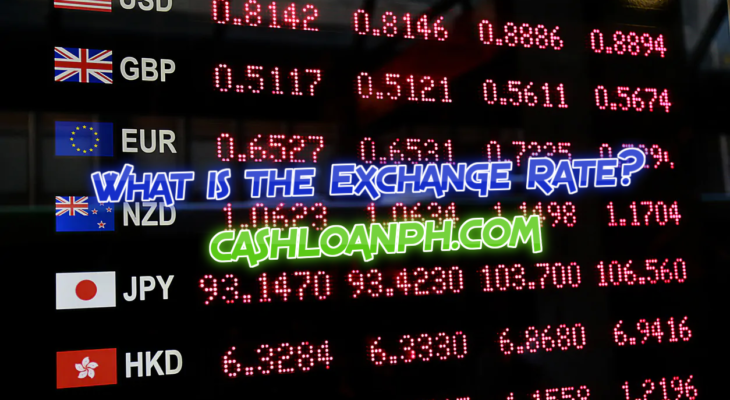Exchange rates play a crucial role in international trade and finance, impacting everything from tourism to investment to global supply chains. However, exchange rates are much more complex than a simple conversion of one currency to another.
In this comprehensive guide, We (CashLoanPH) will explore the classification of exchange rates and delve into the factors that affect them. We will also explain the different methods used to determine exchange rates and discuss the role that exchange rates play in the economy.
What is the Exchange Rate?
The exchange rate is the ratio of the value of one currency to another. In the Philippines, the exchange rate is regulated by the State Bank to ensure transparency and sustainability in the money market. The exchange rate is determined by the supply and demand of foreign currencies.
Check Exchange Rates Today [Lastest Update]
Foreign Exchange Rate
| Bank | Buy | Sell |
|---|---|---|
| BSP | 58.687 | |
| AUB | 58.78 | 59.45 |
| BDO | 56.55 | 57.05 |
| BPI | 56.85 | 57.35 |
| DBP | 58.9 | 59.4 |
| Maybank | 58.55 | 59.25 |
| Metrobank | 58.85 | 59.35 |
| PNB | 58.8 | 59.5 |
| RCBC | 48.13 | 48.63 |
| Security Bank | 59 | 59.5 |
Banks
- BDO Exchange Rate Today
- BPI Exchange Rate Today
- PNB Exchange Rate Today
- LandBank Exchange Rate Today
- DBP Exchange Rate Today
- RCBC Exchange Rate Today
- Metrobank Exchange Rate Today
- Security Bank Exchange Rate Today
- BSP Exchange Rate Today
- Maybank Exchange Rate Today
- AUB Exchange Rate Today
Currency
Exchange Rate Classification
There are several ways to classify exchange rates. Here are some of the most common classifications:
Based on Rate Value
There are two types of exchange rates classified based on rate value:
- Nominal Exchange Rate: This is the exchange rate expressed in current prices, irrespective of the effects of inflation.
- Real Exchange Rate: This exchange rate takes into account the impact of inflation or the purchasing power of a currency pair. It reflects the prices of related products sold abroad or consumed domestically and represents the international competitiveness of a country.
Based on Foreign Exchange Transfer Method
Exchange rates can also be classified according to the foreign exchange transfer method:
- Exchange Rate: This is the rate listed at the bank and serves as the base rate for determining other exchange rates.
- Mail Exchange Rate: This is the exchange rate of foreign exchange by mail and is generally higher than the exchange rate of the letter of exchange.
Based on Time of Foreign Exchange Transactions
Exchange rates can be classified based on the time of foreign exchange transactions into the following:
- Buying Rate: This is the rate at which the bank buys foreign exchange.
- Selling Rate: This is the rate at which the bank sells foreign exchange. The buying rate can be lower than the cost rate, and the difference is the bank’s foreign exchange business.
Based on Payment Term
Exchange rates can be classified based on the payment term into the following:
- Spot Rate: This is the rate quoted by a credit institution at the time of the transaction or agreed upon by the two parties.
- Forward Exchange Rate: This is the exchange rate agreed upon by the credit institutions, and it must be within the prescribed range of the current forward rate of the State Bank at the time of contract delivery.
Based on Object Determined Rates
Exchange rates can be classified based on the object determined rates into the following:
- Official Exchange Rate: This is the rate set by the central bank and is used by commercial banks or credit institutions to set the exchange rate for foreign currency spot trading with a term, swap.
- Market Rate: This is the exchange rate built based on the supply and demand linkage of the foreign exchange market.
Bilateral Exchange Rate
This is the price of a currency against another country’s currency, excluding the inflation of the two countries.
Effective Exchange Rate
This is the multilateral nominal rate or the effective nominal rate.
Exchange Rate Modes
The exchange rate regime refers to the method used by a country to govern its currency in relation to foreign currencies. The exchange rate regime can vary in different countries and time periods.
Types of Current Exchange Rate Modes
Different exchange rate regimes are currently in use, such as:
- Floating Exchange Rates: This is a mode where the value of a currency is fluctuated on the foreign exchange object. A currency that uses a floating rate is known as a floating currency.
- Fixed Exchange Rate: This is a type of exchange rate regime in which the value of a currency is tied to the value of another currency or to another unit of measure such as gold.
- Regulated Floating Exchange Rate: This is an exchange rate regime that lies between floating and fixed regimes.
Factors Affecting Exchange Rates
Several factors influence exchange rates, including:
Inflation Factors
Improving inflation can affect international trade activities, affect the supply and demand of foreign currencies, and cause exchange rates to change.
Interest Rates
Interest rates have a great influence on foreign securities investment activities and affect the exchange rate.
Income
- Direct Impact: National income increases, and the population wants to consume imported goods, so the use of foreign currency increases, causing the exchange rate to rise.
- Indirect Effects: High-income levels lead to increased domestic spending, making the inflation rate high, so the exchange rate increases.
Trade Exchange
Economic Development Situation: If the price of exported goods is higher than the price of imported goods, the domestic currency will rise, which will decrease the exchange rate. If the growth rate of imports is higher than that of exports, the balance of trade will decrease, causing the exchange rate to rise.
Balance of Payments: A high balance of international payments will cause foreign currency to increase, domestic currency to decrease, so the exchange rate will increase, and vice versa.
Exchange Rate Determination Method
Exchange rates can be determined by different methods, including:
- Determination Based on Gold Parity: This method compares the gold content of two coins with each other.
- Determination Based on Purchasing Power Equilibrium: This method is based on comparing the purchasing power of two currencies.
The Role of Exchange Rates in the Economy
Exchange rates play a critical role in the economy and have several functions, such as:
- A Tool to Compare Local and Foreign Currency Values
- Comparing the Prices of Domestic Goods with the Prices of Foreign Goods
- Comparing the Productivity of Domestic and Foreign Workers
Conclusion
Exchange rates are an important aspect of international trade and finance. In this article, we have covered the classification of exchange rates, factors that affect them, and the role they play in the economy.
Understanding exchange rates can provide solutions to stabilize the economy through proper monetary and fiscal policies. By analyzing the exchange rates, one can make informed decisions about investments, purchases, and foreign transactions.



